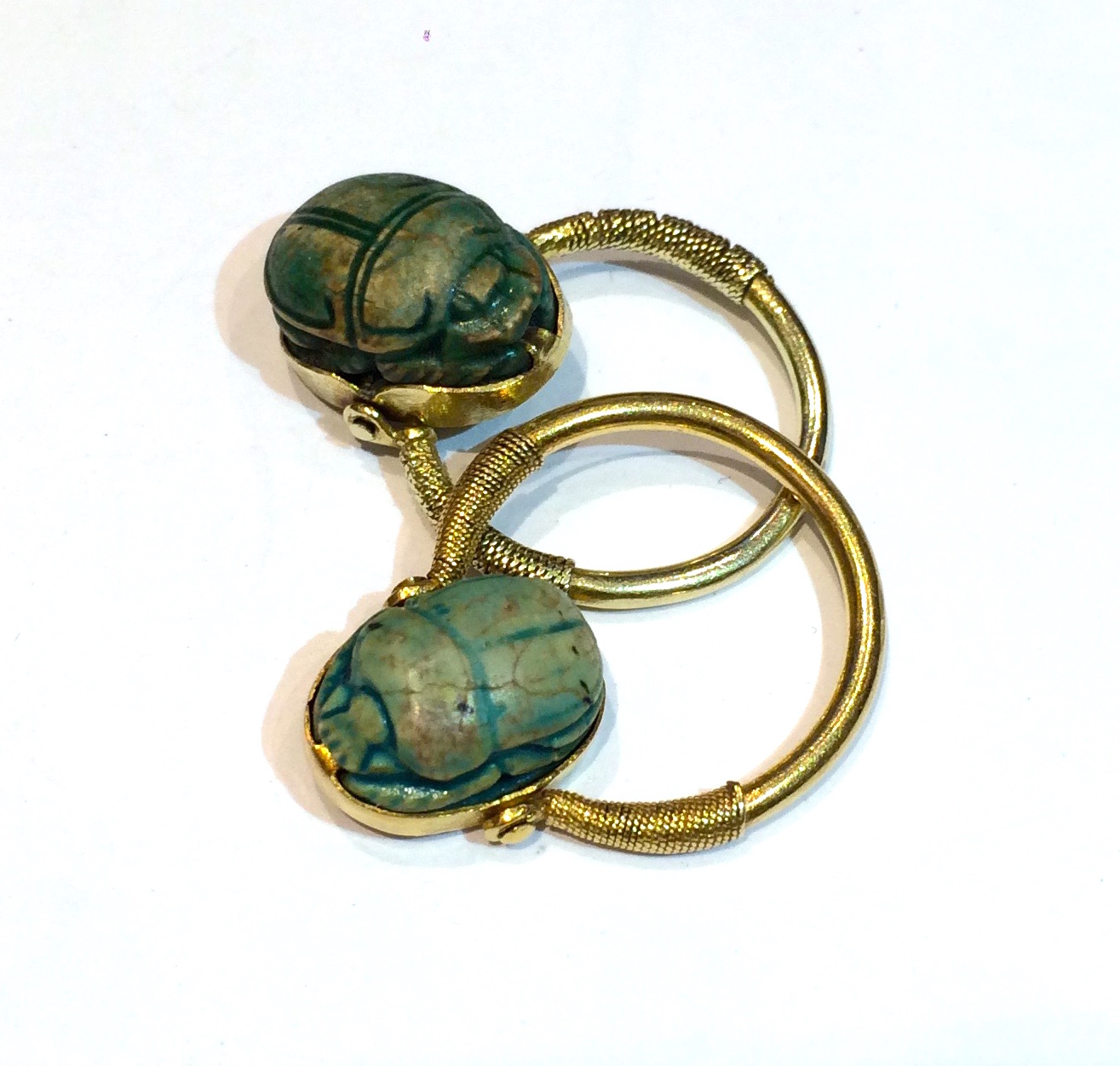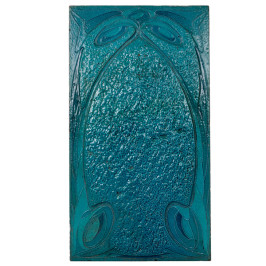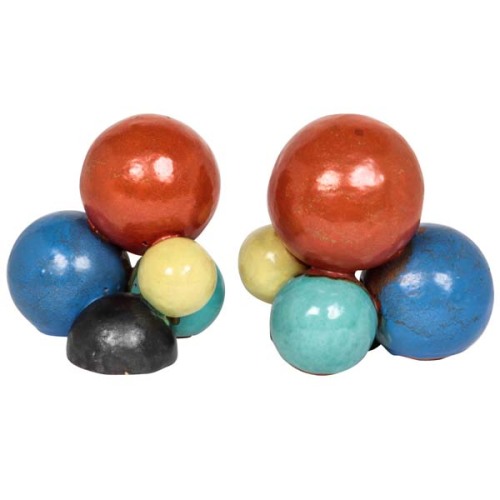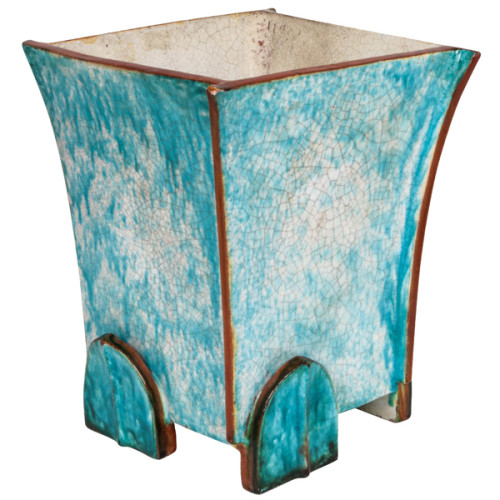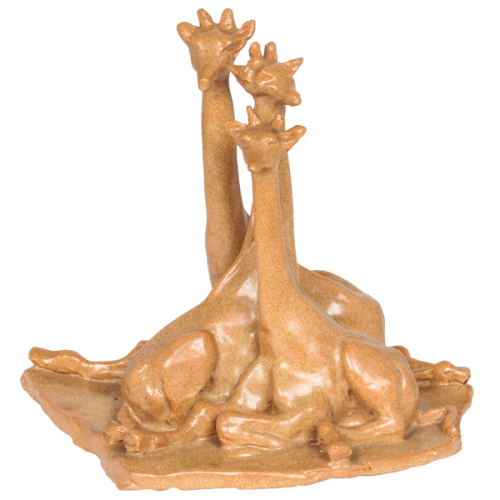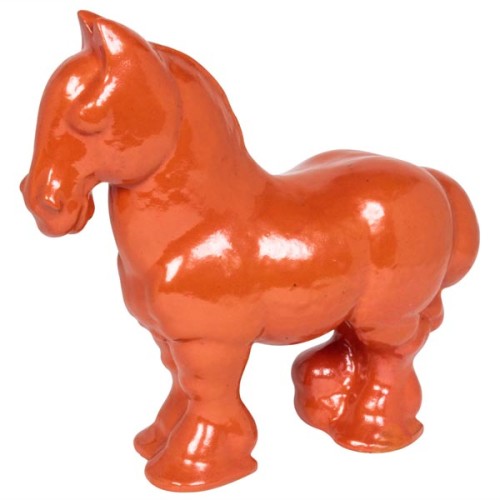glazed
-
Late 19th Century Archeological Revival “Scarab” rings, 18K gold set with glazed ceramic scarabs, c. 1880’s
-
Franco Cannilla / Mario Masenza, Roma “Scarab” ring in an 18k gold expressionistic openwork mounting set with an ancient glazed pottery scarab, signed, c.1950’s
-
Charles Catteau / Boch Freres Keramis Belgium Glazed pottery vase c. 1930
CHARLES CATTEAU (1880-1966)
BOCH FRERES KERAMIS La Louviere BelgiumTulip vase c. 1930
Glazed earthenware
Marks: “Keramis” Made in Belgium , D. 2524 B, 945
H: 10 1/4″ x D: 6 1/2″
Charles Catteau could be regarded as one of the most versatile ceramic artists of his generation, especially for the style of Art Deco. Catteau advanced the forms, techniques and decoration of modern ceramics, creating an exceptionally original, new and decorative genre.
Hired as a ceramic decorator in Ecole Nationale de Sèvres from 1903 to 1904, he began producing designs that were rather traditional, based on the observation of nature, and showing the influence of Japonisme, characterized by pure lines and meticulous details. From 1904 to 1906, he worked in Nymphenburg Porzellan Manufaktur near Munich, a factory specializing in new hand painting procedures under a slip, as well as Art Nouveau.
In 1907 he finally moved to Louvière in Belgium where he was promoted to head of the decoration department at Boch Freres Keramis at the age of 27. This is where most of his exceptional talent came to the fore especially during the period between the two World Wars. Influenced by the great creative art movements of the time (Africanism, Japonisme, Cubism, Abstraction) and his observation of nature gave him inspiration for his designs, with the integration of plants, stylized animals and geometric motifs. The international avant-garde movements were also an influence leading to his use of purely abstract, geometric designs and intense colors. Charles Catteau was incredibly resourceful and explored various harmonies of form, techniques, designs, colors, shades, topics, variants and influences. In this way Catteau became a representative par excellence of Art Deco designs, giving it his personal touch. He was instrumental in introducing technical innovations during the 20’s and 30’s to aid mass production of ceramic products and expand availability of affordable products. During difficult times in Europe, he created vivid, colorful, original and uplifting ceramic wares.
Charles Cotteau motto was “Art for All” and he also taught decorative painting at the School of Industrial in Louvière. In 1925 he obtained international recognition in the exhibition of Decorative Arts in Paris. which helped raise the profile of Boch Freres. He remained at the company until he retired to Nice in 1946 .
-
Hector Guimard for Maison Coilliot / Art Nouveau glazed lava tile 1898
HECTOR GUIMARD (1867-1942) France
MAISON COILLIOT Lille, FranceTile c. 1898
Fired and glazed lava with abstract whiplash motifs in various tones of aqua blue on the obverse and a partial graphic on the reverse with polychrome floral and linear details.
Marks: 16 (on top of tile)
French architect Hector Guimard (1867-1942) realized the decorative possibilities of glazed lava, a substance made from mixing pulverized lava with clay when he built a villa for Louis Coillot, (1898-1900) a ceramics manufacturer in Lille who monopolized the distribution of the material. Guimard sided the entire facade of Maison Coilliot in lava stone.
***A related glazed lava tile from the Castel Henriette is in the Collection of the Musee d’Orsay.
The Maison Coilliot is an Art Nouveau house located on 14, rue de Fleurus in Lille, France. Louis Coilliot, a French ceramic entrepreneur, was fond of enameled lava and wanted to popularize the technique. To do so, Coilliot commissioned Hector Guimard, an architect he’d met at the 1897 fair La Céramique et tous les arts du feu, (“Ceramic Arts & Glass Making”), to apply the technique to his house’s façade. Coilliot’s factory and warehouse were located to the rear of his house, and therefore the façade held a double
purpose, both decorating the front of his home and advertising his business.For more information see: Hector Guimard, 1867-1942: Architektur in Paris um 1900 (Munich: Museum Villa Stuck, 1975)
H: 25 1/2″ x W: 14″ x D: 9/16″
-
Edmond Lachenal French Art Nouveau Green glazed pitcher / vase form c. 1900
EDMOND LACHENAL (1855-1930) Paris, France
Green glazed pitcher / vase form c. 1900
Marks: E LACHENAL (impressed and glazed in a rectangle on base)
For information on Edmond Lachenal see:”Edmond Lachenal”, Fritz Minkus, Kunst und Kunsthandwerk, IV (1901) pp.390-98; La Céramique Art Nouveau, Edgar Pelichet and Michèle Duperrex (Lausanne: Les Éditions du Grand-Pont, Switzerland, 1976) pp. 66,71,74,78,83,112,115; “l’Atelier Lachenal à la galerie Georges Petit “ in Les Echoes d’Art” (1933), p. Vll; Art Nouveau: Belgium & France, exh. cat. Yvonne Brunhammer et al. (Houston, TX: Institute for the the Arts, Rice University, 1976), p. 48; Le Japonisme (Paris: Éditions de la Réunion des Musées Nationaux, 1988) cat no. 377, p. 321; Japonisme: the Japanese influence on western art in the 19th and 20th Centuries, Siegfried Wichmann (Parklane: New York, 1980) pp. 339, 349; cat. no. 920.
H: 9″ x W: 6 3/4″
-
Walter Bosse / Austrian Keramik Art Deco Glazed Pottery Bookends c.1930
WALTER BOSSE (1904 – 1979) Austria
Bookends c. 1930
Hand-painted and glazed earthenware
For more information see: Walter Bosse: Leben, Kunst, und Handwerk, 1904-1979, Cherica Schreyer-Hartmann, Hans Hagen & Johanna Hottenroth (Vienna: Verlag Christian Brandstätter, 2000), Wiener Keramik: Historismus, Jugendstil, Art Déco, Waltraud Neuwirth, (Braunschweig: Klinkhardt & Bierman, 1974), pp. 114-115.
H: 5″ x D: 4 1/2″ x W: 5 1/4″
Price: $2,250
Walter Bosse (November 13, 1904–December 13, 1979) was a Viennese artist, designer, ceramist, potter, metalworker, and craftsman noted for his modernist bronze animal figurines and grotesques.
Walter Bosse, born November 13, 1904, in Vienna, was the son of artists Luise and Julius Bosse. His father worked as a portrait painter at the imperial court. Walter Bosse attended the Wiener Kunstgewerbeschule (Vienna School of Applied Arts) from 1918 to 1921, where he studied ceramics under Michael Powolny, and ornament under Franz Cižek. He then attended the Münchner Kunstgewerbeschule (Munich School of Applied Arts). During his schooling he was given the opportunity to sell his work at the Wiener Werkstätte by Josef Hoffmann, who became a mentor to Bosse. Bosse opened his own shop in Kufstein in 1923.
Bosse’s work grew in popularity and a number of his pieces were shown at the International Exposition of Modern Industrial and Decorative Arts in 1925. He started designing for Augarten Porcelain Works (1924) as well as Goldscheider (1926) and Metzler and Ortloff (1927). In 1931, to meet increasing demand (especially in America), Bosse opened up a bigger shop in Kufstein, but by 1933 he started to feel the effects of the economic depression. By 1937, the Kufstein works were closed.
In 1938, now divorced, Bosse moved back to Vienna where he founded Bosse-Keramik (Bosse Ceramics), which expanded under the new name “Terra” to include glass, toys, textiles. and a variety of craft items for the gift market. In the late 1940s, Bosse began experimenting with brass by giving his ceramic figures a metal coating to protect them from breakage. In the early 1950s, Bosse began his “Black Golden” line of brass figurines. He transitioned all of his efforts to brass. The figures became popular worldwide.
Despite Bosse’s success with his brass figures, it was still a difficult time for him financially. In 1953, partly fleeing from financial troubles, he moved to Iserlohn where he set up a new shop and continued production. Bosse also collaborated with Karlsruhe State Majolika Works on a number of pottery animal figures. In 1958, he designed for Achatit Schirmer in Cologne. Bosse also turned his efforts to small, everyday items such as letter openers, keyrings, corkscrews, and pencil holders, all of which bear his distinctive “black and gold” look. A number of these Bosse designs began to gain widespread popularity internationally.
-
Czech Modernism Creamy white glazed earthenware vase c. 1920
CZECH MODERNISM
Vase c. 1920
Creamy white glazed earthenware
Marks: Made in Cecho-Slowakia
H:10″ x W:8″ x D: 6″
Price” $2,200
-
Münchner Werkstätten / Art Deco Large Glazed Pottery Vase c. 1928
MÜNCHNER WERKSTÄTTEN Germany
Vase c. 1928
Blue and white modeled glazed earthenware with orange red outlines
Marks: “M” over “W” mark, Germany
Provenance: Mr. Ernest L. King (Watkins) “Rockledge” Commission, Winona, MN c.1930’s Phillip Brooks Maher (interior architect), descended in the King Family to Bud (E. L. King Jr.) and Betty King, Winona, MN, Hollander Gallery, Milwaukee, WI, Private Collection, New York, NY
H: 9 ¾” x W: 8 ¼” x D: 8 ¼”
Price: $5,450
ROCKLEDGE, the summer home of Ernest and Grace King (the Watkins Family Company fortune was made from door-to-door sales of health potions and hygiene related products) was built and designed in its entirety from the expansive main home building with all of the furnishings to the custom silver service all the way down to the hand woven carpets and lace curtain designs, is arguably the most famous American Arts and Crafts commissioned home in America and was built and meticulously designed by George Washington Maher. It was finished in 1912, and was used by the Kings for the month of August only for a couple of decades before the interior was completely redone in the fashionable Art Deco design of the 1930’s. George Washington Maher’s son Phillip Brooks Maher, was hired for the project and went shopping for the best of the design of the period in both New York and Paris. He assembled a legendary collection of Art Deco design that comprised many important examples of both American and European Art Deco including the famous Donald Deskey square form telescope table, a Gilbert Rohde “Z” clock, a pair of Mies van der Rohe red lacquer and wicker armchairs, DIM furniture and rugs from Paris and rare Paolo Venini floor lamps and sculptural glass pieces among many other major 20th Century design works. This rare vase was indicative of the avant-garde furnishings throughout the King Home as well as the exquisite quality and attention to the detail of every single object that the Kings surrounded themselves with and became accustomed to enjoying and living with whether they were at their Daytona Beach resort, their lakeside property at Lake Tahoe or their plantation in Hawaii!
-
Hulda Rotier Fischer Art Deco “Giraffes” handbuilt glazed pottery sculpture 1936
HULDA ROTIER FISCHER (1893 – 1982) Milwaukee, WI
Three-resting giraffes sculpture 1936
Handbuilt earthenware sculpture with a golden light brown glaze.
Marks: Hulda Rotier Fischer 36 (hand incised)
H: 6 1/2″ x W: 7″ x D: 5 1/2″
Price: $2,300
Hulda Rotier Fisched studied at the Milwaukee Normal School and was a student of Robert von Neumann Sr. In 1921 she also studied with Carl Holty. She worked as an Art Instructor at Shorewood Opportunity School for 30 years. Rotier Fischer was a Member of the Milwaukee Art institute.
She is the recipient of many Milwaukeee Journal Awards.
-
Walter Paul Suter, American Art Deco glazed pottery sculpture 1929
WALTER PAUL SUTER USA
AMERICAN ENCAUSTING TILING CO. New York, NY
Art Deco Seated Female Figure with Draped Skirt and Holding an Art Deco Vase 1929
Hand-modeled and molded cream glazed earthenware figure with gold and silver details on a separate, but matching black glazed earthenware base.
Signed: SUTER ‘29 (under glaze on back right hand corner)
H: 13″ x D: 7 1/2″ x W: 9″
Price: $14,500
Walter Paul Suter was born in Basel, Switzerland in 1902 and studied there at the School of Fine and Applied Arts. He moved to the United States in 1924 and settled in New York. He was a member of the American Ceramic Society, as well as the Society of Swiss Painters, Sculptors & Architects. In 1932 Suter won first prize in the Robineau Member Exhibition in Syracuse. He was a member of the American Encaustic Tiling Company in NYC.
-
Pedro de Lemos / Art Deco Orange glazed American Pottery Clydesdale Horse Sculpture c. 1930
PEDRO DE LEMOS (1882-1945) Bay Area, California
Clydesdale horse sculpture c. 1930
Hand modeled orange glazed terra cotta.
Marks: De Lemos Palo Alto (sticker on the bottom), various pencil notations on the foot bottom
H: 9 1/8″ x D: 3 1/2″ x W: 9 1/2″
Pedro Joseph de Lemos (25 May 1882 Austin, Nevada – 5 December 1945) was an American painter, printmaker, architect, illustrator, writer, lecturer and museum director. He started his art career in the Bay Area. He studied under Arthur Frank Mathews at the Mark Hopkins Institute of Art in 1900, later was a student of George Bridgman at the Art Students League in New York and of Arthur Wesley Dow at Columbia University Teachers College. The influence of traditional Japanese woodcuts is clearly seen in his work.
Pedro’s father Francisco, a cobbler, emigrated from the Azores in 1872, and settled in Oakland, California where Pedro was educated. Pedro and his brothers Frank and John all followed careers in art. Pedro was employed by Pacific Press Publishing Company between 1900 and 1906, afterwards starting the Lemos Illustrating Company with his brothers in 1907. Later this became known as the Lemos Brothers Art and Photography Studio, which offered art classes in copper, leather and landscaping as well as the traditional media of drypoint, etching and illustrating.
Lemos worked from a studio overlooking Lake Merritt and taught art at the University of California, Berkeley, working at the same time as illustrator and designer and giving classes in decorative design and etching at the San Francisco Institute of Art, where he had earlier studied when it was the Mark Hopkins Institute. He helped found the California Society of Etchers and an aqua print of his was acclaimed at the 1915 Panama-Pacific International Exposition, for which he helped organise the California print exhibition. He filled the position of Professor of Design at Stanford University and became director of the Stanford University Museum of Art in 1919. Besides being the first president of the Carmel Art Association, he was an affiliate member of several art organisations such as the California Society of Etchers, the California Print Makers, the Palo Alto Art Association, the Chicago Society of Etchers and the Bohemian Club. In 1943 he was elected a Fellow of the Royal Society of Arts in London.

